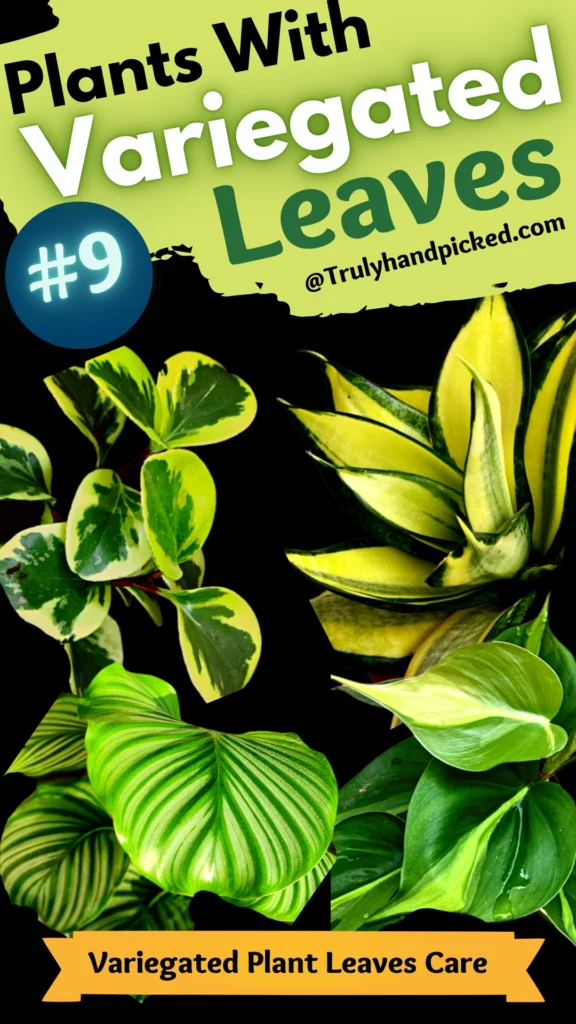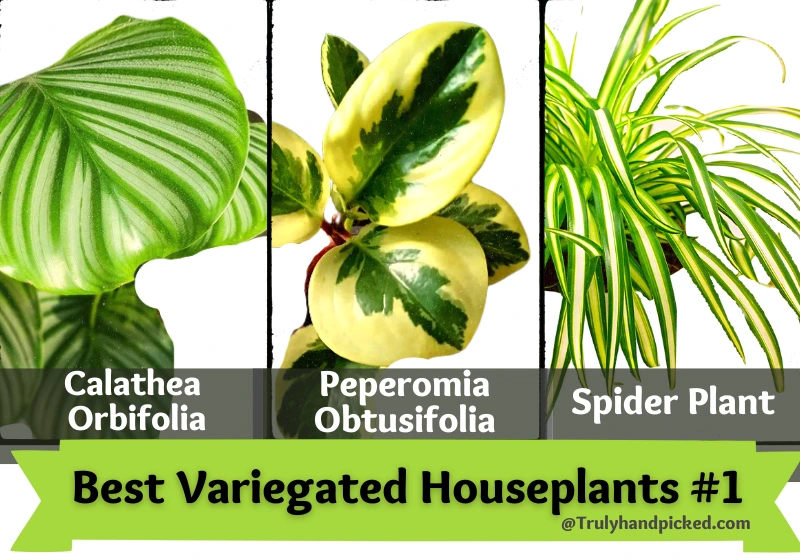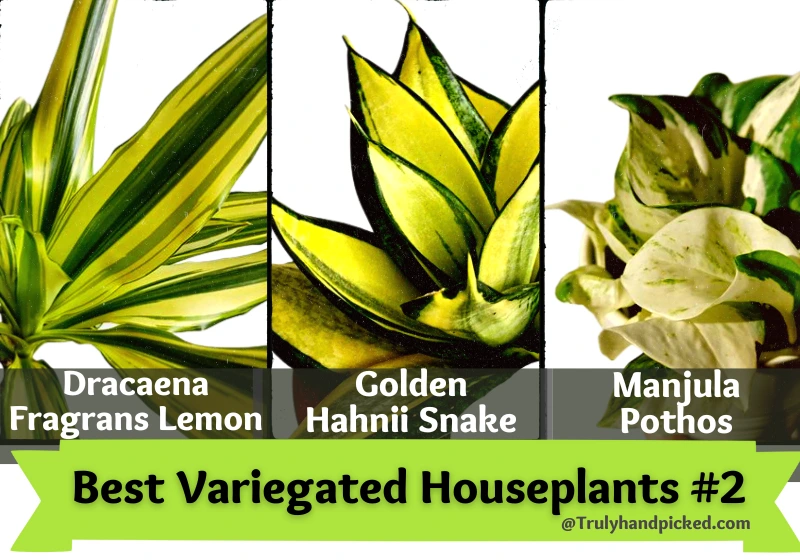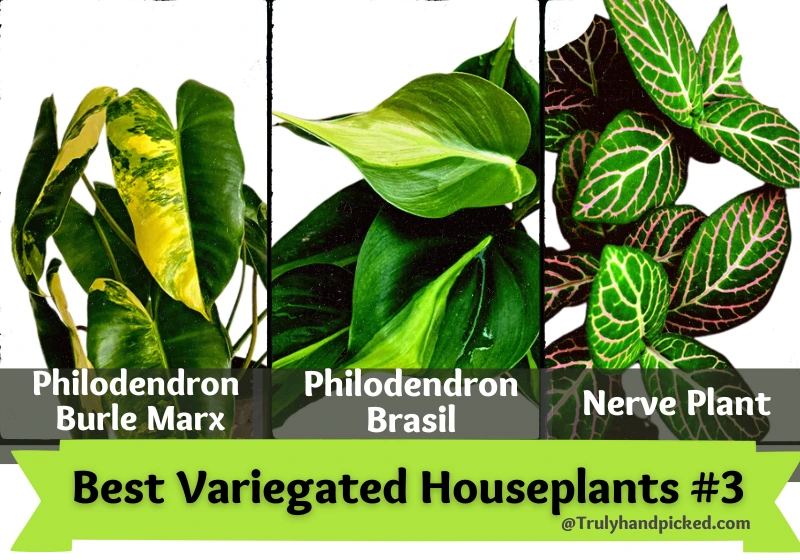Variegated plants are those species, which grow foliage in more than one shade, unlike normal plant leaves. Consequently, such plants provide an exclusive ravishing look to your plant when you cultivate them indoors.
Before we jump to the list of variegated houseplants check out the following
Variegated Indoor Plants Essentials
- Fertilizer for Varigated Houseplants: Don’t fertilizer and avoid high nitrogen fertilizer for variegated plants. As these plants won’t be able to withstand the extra nitrogen from regular fertilizer. If you choose to fertilize go for low-nitrogen fertilizer that too is limited.
- Variegation loss in certain plants: Your plants lose variegated leaf patterns and colors because of tap water, chemicals, and light sensitivity of the plant. In few plants lost variegation in a plant cant be reversed.
- Sunlight: Yes variegated plants need more sunlight than solid green plants. As solid green plants can manage with low light but, variegated with two tones or change in leaf color will need bright sunlight to maintain the variegation. So with little chlorophyll in leaves, they manage to absorb more sunlight for their life.
You need to take extra care to keep their unique-looking leaves exactly the way they grow. In reality, it is not a difficult job for any garden enthusiast, even if you grow such variegated plants indoors!
All you need to do is just follow some simple caring tips attentively. So, here we emerge with some of those tricks for you to enjoy the super charming and aesthetic display of these variegated plants as long as you can-
Best Variegated Houseplants to Turn Your Rooms Attractive
Calathea Orbifolia:
Calathea orbifolia is a charming variegated plant you can easily grow indoors in a restricted planter. This species of calathea caters to the largest category of its genus. The deep green foliage grows with some striking silver strips.
- It prefers moist but well-drained soil
- Place it in a warm high-humid place
- Provide the plant sun with partial shade
- Water your plant regularly or with one-day gaps
- And feed it with any diluted normal fertilizer once a month
Peperomia Obtusifolia:
Peperomia obtusifolia is a kind of baby rubber plant. It grows easily as a houseplant and resembles appealing for its super-classy foliage.
This plant is a succulent that produces leaves in a unique look with three elegant shades of creamy white, olive green, and deep green. Stems are tender of this plant, while leaves are fleshy and grow with a glossy texture.
Some Basic Caring Tips:
- Grow your plant in rich potting soil that drains well
- It requires bright but indirect light constantly
- Place the planter in a warm high-humid place
- Water your plant when the top surface of the soil turns dry about 1-2 inch depth
- Apply an all-purpose fertilizer in a 10-10-10 NPK ratio only 2-3 times a year
Spider Plant – Chlorophytum Comosum:
If you want to grow a variegated houseplant within a limited space with less maintenance, the spider plant is the right choice for you. Several nature-lovers agree to grow this decorative houseplant at their house due to its easy-to-grow quality, besides its appealing look.
Leaves of this plant grow in dark green shades with pale white stripes, which give them a ribbon-like display.
Some Basic Caring Tips:
- Plant this in a loamy potting soil that can drain extremely well
- Water your plant only when the top of the soil turns completely dry
- Place the planter near a west-facing window to provide indirect sunlight
- Don’t fertilize your plant often and apply only with normal plant food in liquid form
- Make sure you put the plant in a moderately warm and high humid place consistently
Dracaena Fragrans Lemon Lime:
It is one more beautiful-looking variegated plant to grow indoors effortlessly. The plant produces long sleek leaves in the deep green shade with lemon-green edges and white stripes.
Foliage directly grows from one single central stem and spread up to 2-feet long. Some leaves of this plant can grow with pretty yellowish hues sometimes, which provide the plant a more delightful glance to resemble.
Dracaena care:
- The plant prefers good potting soil which drains quickly to prevent root rot
- Try to water your plant only when the soil turns totally dry
- Place the planter in a high-humid spot and never let the soil turn soggy ever
- Provide your plant indirect bright sunlight with a temperature between 60-80 degrees F
- Don’t overfertilize or overwater your plant to avoid brown-leaf problems permanently
Golden Hahnii Snake Plant:
If you are looking for a tough variegated houseplant then, the golden hahnii snake plant is the best pick for you. This plant can tolerate normal room temperature and thrives in a standard climate without any additional effort.
It is a small variegated plant that can’t grow high more than 6-inch even after full maturity. Foliage grows in the shiny green shade with striking yellowish margins and in tight rosettes shape.
Watering around the edge instead of watering near or on the stem will prevent rotting.
Quick care tips:
- The plant requires fast-draining loose potting soil to grow
- Allow the soil to dry totally between watering sessions
- Try to keep the leaves dry during this process
- Feed your plant with all-purpose fertilizer two-three times a year
- And place it in a spot where it can get bright but indirect light 6-7 hours a day
Manjula Pothos:
Manjula pothos is the most stunning pothos species that you can grow easily indoors. This variegated plant grows huge heart-shaped leaves in a unique color combination.
The foliage of this pothos plant comes with pretty designs in white, green, and cream-colored variegation. It is one more hardy houseplant to cultivate easily in the variegated category.
Can Manjula pothos revert back? Yes chances Manjula pothos can revert back to dark green leaves under low light conditions. Since variegated leaves has less chyrophyll, if enough light is not available chances are they can revert back to balance the light vs chlorophyll
Some Basic Caring Tips:
- This species of pothos prefers loamy and acidic type soil with well-drained quality
- Keep the soil evenly moist and let the soil dry between the watering session
- It prefers high humidity and moderately warm temperature with indirect light
- Feed your plant once a month with any balanced liquid fertilizer
- And give your golden pothos enough space to thrive fully
Philodendron Burle Marx:
Philodendron Burle Marx is a small-grown variegated houseplant, that can reach only 2 feet of height while fully grown.
This low-growing tropical shrub produces big heart-shades leaves in a bright green shade. Its variegated category grows the same types of leaves but with pretty variegation in two different types of green shades.
Some Basic Caring Tips:
- This plant prefers moderately rich, mildly acidic well-drained soil
- Water your plant regularly to keep the soil moist consistently
- It prefers a low-light environment with moderate humidity
- The plant thrives best in bright but indirect sunlight under the sun with partial shade
- And try to provide your plant with any slow-release fertilizer that is rich in nitrogen content.
Philodendron Brasil:
Philodendron brasil is a variegated flowering species of the Araceae family. This genus produces small heart-shaped leaves with a combination of deep and light green shades.
Its small-grown quality makes this one a great pick as a variegated houseplant. Some species of philodendron brasil are quite a veining plant thus, you can provide some climbing support near your planter if you want.
Philodendron Brasil quick tips:
- This plant prefers airy acidic soil with well-drained quality
- Water the place after 2-3 weeks as it wants less water to thrive
- Place your planter in a spot where the plant could get low-mediumly bright light indirectly
- Feed your philodendron brasil plant with liquid plant food that is rich in micronutrients
- And don’t forget to report your planter once it overgrows its current planter noticeably.
Nerve Plant:
This one more brilliant option to go with, to decorate your place with a low-maintenance variegated houseplant. The nerve plant is a perennial species that produces leaves in dark green shades.
Foliage grows with silvery-white veined designs, which provides the plant an unforgettable classy resemblance.
Nerve Plant Care:
- Nerve plant prefers loose, well-drained type soil with a neutral pH level
- Like other variegated plants, this species of nerve plat also requires indirect sunlight
- Place the planter in a high-humid spot where it can get dappled sunlight
- Water your plant after 4-7 days and let the soil dry a little between watering
- And feed it with any NPK balanced fertilizer in diluted form.



